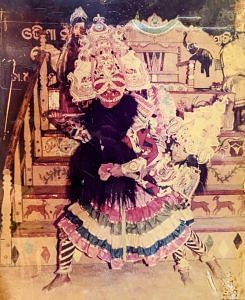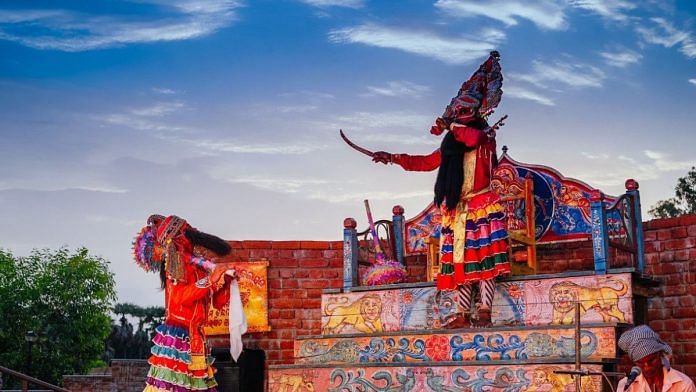A musical theatre form most popular in Odisha today, Prahlad Natak enacts the story of Prahlada, the son of the demon king Hiranyakashipu, who is rescued by the god Narasimha. This episode, derived from the Puranas, is enacted in every Prahlad Natak with some variations between individual performances.
The form has been compared to the theatre genres of therukoothu and yakshagana, though Prahlad Natak is most closely related to svang and Odia jatra. Performances typically take place in an open area demarcated by ropes. A wooden platform with a prop chair representing the throne of Hiranyakashipu is constructed behind it. The actors are accompanied by musicians playing the harmonium, the mardal (a double-ended drum), trumpets, the mukhaveena (a wind instrument), conch shells and gini (cymbals). One hundred and twenty-six songs, encompassing about thirty-five ragas and six talas and generally derived from traditional Odia music, are sung; forty-two Sanskrit and eleven Odia verses are also recited.

The director of a Prahlad Natak may also serve as the lead vocalist or the gahaka. He sings praises of characters, leads the chorus and directs musicians. The chorus consists of three to four subsidiary singers who also participate in the enactment of the songs. The gahaka’s role in the play is akin to that of a sutradhar: he makes comments on the characters and the action taking place for the audience.
Also read: What is Pachisi? Ancient Indian board game Mughal emperor Akbar enjoyed
The performance adheres rigidly to a performance text, with no room for improvisation by the actors. The performance text consists of one long sequence that is not divided into scenes or acts, differentiating it from the structure of most Indian classical dramas. It is composed instead of musical sequences connected by prose dialogue. The play generally has twenty male and five female characters, with the primary characters being Hiranyakashipu, Prahlada, Ganesha and Narasimha. The characters are depicted through the use of elaborate costuming and masks. Hiranyakashipu and Narasimha are physically demanding roles, and are usually performed by the most experienced performers of a troupe. Prahlada is played by a young apprentice, and supporting characters are played by amateurs associated with the troupe.
The first written Prahlad Natak text was composed in the late nineteenth century by the poet and dramatist Gopinath Pariccha using Sanskritised Odia. It was collected in 1938 and is housed in the Madras Oriental Manuscript Library. Pariccha was patronised by the zamindar Ramakrishna Chhotaraya of Jalantar (in present-day Srikakulam district, Andhra Pradesh), who is credited with conceiving the first performance. Prahlad Nataks soon began to be conducted in neighbouring areas, following the same play but with some performative variations. This proliferation soon transformed Prahlad Natak into a theatrical genre based on a single play. The form lost royal patronage in the twentieth century and is today supported by rural audiences.
Prahlad Nataks are still performed in the Ganjam district of southern Odisha by some travelling troupes, but its popularity has declined significantly in recent years.
This excerpt is taken from MAP Academy’s ‘Encyclopedia of Art’ with permission.
The MAP Academy is a non-profit, online platform — consisting of an Encyclopedia, Courses and a Blog — which encourages knowledge building and engagement with the visual arts of the region.



